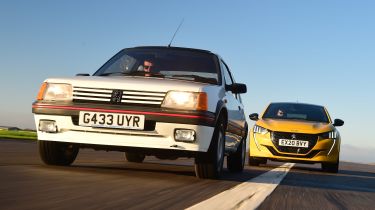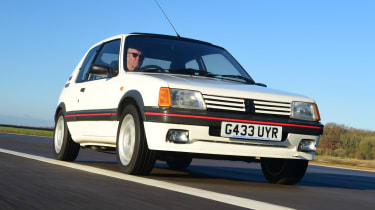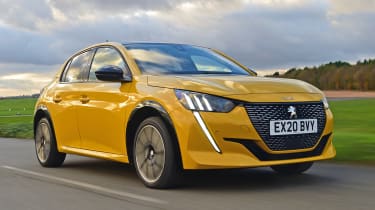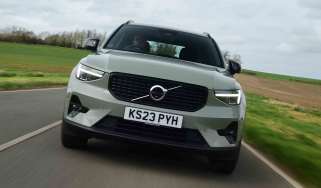Old vs new: Peugeot 205 GTI vs Peugeot 208
As the Peugeot 205 turns 40, we look at how this most iconic of French superminis has influenced the brand’s latest small car
In the early eighties, the supermini class underwent something of a revolution. Ford’s second-generation Fiesta, the Vauxhall Nova and the Nissan Micra all hit UK dealers within a year or two of one another, transforming the small-car landscape. But there was one car that blew all of those away when it came to ability, desirability and choice.
Until 1984, Peugeot was a brand best known for producing chunky, bulletproof saloon cars, but it desperately needed a replacement for its ageing 104 hatchback. The result was the 205 – a supermini which set the standard that all other small cars would have to live up to for the rest of the decade.
The 205 proved to be a runaway success for Peugeot. Between 1984 and 1998, over 5.3 million units were sold, and it troubled the top of the sales charts throughout Europe. Buyers couldn’t get enough of the stylish French fancy, with crisp clean lines and neat proportions setting a template that the brand would follow with models into the nineties.
Indeed, it’s a car that Peugeot still looks back on proudly, and draws on as inspiration for all of its latest superminis. Today’s 208 is part of a model line-up that shows the French company is back on the kind of roll that it hasn’t seen since its heyday at the end of the last century.
Used - available now
So for the 205’s 40th anniversary, we’ve lined up old and new to see what made the original so special – and how the new car has moved the game on.
Peugeot 205 GTI
| Model: | Peugeot 205 1.9 GTI |
| Price: | £11,275 (1989), £15,000 (now, est) |
| Engine: | 1.9-litre 4cyl petrol |
| Power/torque: | 130bhp/165Nm |
| Transmission: | Five-speed manual, front-wheel drive |
| 0-62mph: | 7.8 seconds |
| Size (L/W/H): | 3,705/1,589/1,350mm |
The 205 was offered with a range of petrol engines starting off with 45bhp, and a couple of cutting-edge 1.8 diesel units. However, here we’re driving the 205 in its hottest form, the 1.9 GTI – an immaculate example kindly loaned to us by its owner, Andrew.
It’s at its most striking like this; chunky wheelarch extensions were fitted to house a wider track and 15-inch wheels, while the look was completed with subtle red pinstriping. More modest versions were available in five-door form, and a cabriolet – designed with input from Pininfarina – offered open-top thrills.
But it was more than a pretty face. Although the car is just 3.7 metres long, its cabin is surprisingly spacious, and the boot is wide and square. Rear trailing arms and torsion bars, which were low, compact and easy to package, helped here.
Climb into the 205’s cabin today, and there are a number of things that strike you. Firstly, this car was from a time when French cars did not have the finest reputation for interior quality. The plastic is thin and flimsy, and various parts creak and buzz against one another as the chassis flexes around them. It’s hard to fault the ergonomics, though. The controls are neatly laid out, the dials look fantastic and the GTI’s various clocks are displayed clearly, while the visibility is absolutely superb all round.
As you’d expect from a hot hatch, GTI models gained some exciting design flourishes. A pair of more supportive front seats have red and black woven inserts to match the red carpet that instantly gives a sporty vibe. The three-spoke steering wheel looks great, but the twenty-past-eight position of the thumb grips means that it’s not that natural to hold when you’re driving enthusiastically.
The 205’s equipment list is also fairly modest. Central locking, electric windows and a four-speaker cassette player were standard on this 1.9 GTI, but that’s as cutting-edge as things get.
Most of all, though, the 205 was – and still is – huge fun to drive. Modern hot hatches are grippier, faster and more sophisticated, but none has this amount of character, interaction and feedback. You can play with the car’s balance on the throttle mid-corner, helped by the unassisted steering that transmits loads of feedback through its rim.
The 1.9 GTI produced 130bhp – modest by today’s standards – but at just 880kg, it was light, too. As a result, its 0-62mph time of 7.8 seconds put it within a second of a contemporary BMW M3. Every trip to the red line is backed by an angry-sounding four-cylinder engine that feels muscular low down and strong throughout. Each shift is engaged as quickly as you can move your left hand, while the pedals are perfectly placed for heel-and-toe downshifts.
Best of all, these well judged controls could be found on even the most basic variants – a quality lost in many modern superminis. Keen drivers on small budgets were spoiled for choice 40 years ago.
Peugeot 208 GT Line
| Model: | Peugeot 208 |
| Price: | £24,710 (GT) |
| Engine: | 1.2-litre 3cyl turbo petrol |
| Power/torque: | 99bhp/205Nm |
| Transmission: | Six-speed manual, front-wheel drive |
| 0-62mph: | 9.9 seconds |
| Size (L/W/H): | 4,055/1,745/1,430mm |
It says a lot about how much 205 values have shot up in recent years that, in order to buy a GTI like the car on the previous page, it’ll cost you similar cash to this three-year-old 208, loaned to us by bravoauto and, at the time of writing, on sale for £13,567.
The newer car has a huge list of standard tech, much of which had barely been imagined when the 205 was released; LED headlights, DAB radio and a digital instrument panel that even houses a G-meter are all standard. But with Peugeot pitching the 208 as the posh option in the class, such tech is a necessity.
Multi-coloured ambient lighting can’t prevent this car’s cabin from feeling dark, though – and not just because of the lack of red carpets. Blame the smaller windows all round – a worthwhile side effect of vastly improved crash protection in newer cars, but one that also limits rearward visibility to the point where a reversing camera becomes a vital feature.
It’s not just safety where things have moved on massively, though – not only for the supermini segment as a whole, but for Peugeot in particular. Even in the 205’s era, its dashboard felt a bit flaky compared with the class average. By contrast, the 208’s cabin doesn’t just look more modern than almost any of its direct rivals, but its overall quality is a cut above, too. Sturdy, soft-touch plastics sit well alongside intricate piano-style shortcut keys on the dashboard, and the use of fabrics on the doors and dash makes it easy to believe you’re sitting in a premium product.
As in its great, great grandfather, the steering wheel is a slight bone of contention, though. Here, it’s because of Peugeot’s i-Cockpit layout, which places a tiny steering wheel beneath a set of digital dials. That’s the theory, anyway, but if you choose to rest your hands at a similar level to where you would in any other car, then there’s a strong chance that the top of the wheel will be blocking much of the display.
On the road, the differences between the two cars are stark. The 208’s refinement is among the best in its class, and as such, engine and road noise – particularly the knocks and bangs from the suspension – are superbly muted here compared with in the 205. Beside the slightly intense experience of the 205, the 208 is positively soothing.
But it certainly isn’t as much fun. The 208 is set up to be composed, grippy and secure – and it is – but it doesn’t have the same magic as the 205. It isn’t short of punch, though. The 208’s 1.2-litre three-cylinder’s forced induction gives it, fittingly, 205Nm of torque, which helps the 208 pull strongly from tickover. It comes into its own at motorway speeds, where it’s impressively up to the task of covering long distances – while breaking 50mpg without a sweat.
Click here for our review of the new all-electric Peugeot E-208...










